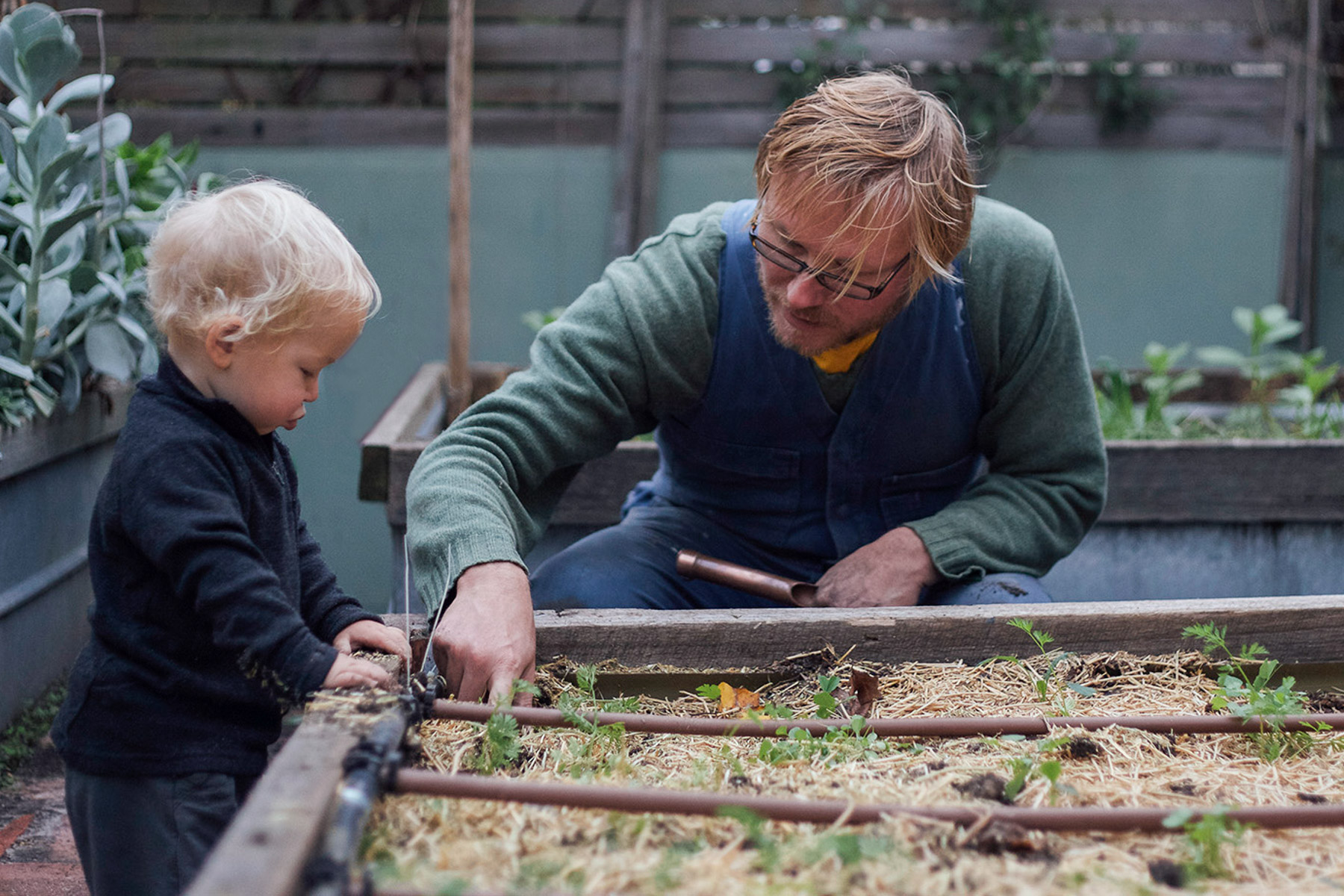Most of our homes have a bit of outdoor space in which to make a garden. Time spent in a garden can induce a sense of peace and calm or mindfulness. As well as creating beauty, a garden brings a connection with nature, its seasons and rhythms. The understanding of this connection, of working with nature to nurture oneself, is most clearly expressed in a permaculture garden. Miri Ransom works in collaboration with Megan in the Brave new eco team designing landscape solutions and creating detailed planting plans. In this article she outlines our particular approach to urban permaculture design; Firstly to create environments that match the landscapes and inhabitants physical and practical resources, and secondly to create productively useful and ecologically beneficial environments, that are also aesthetically beautiful. You can hear more of Miri's garden musings at her Daily Gardener blog.
WHAT IS PERMACULTURE?
Permaculture is the conscious design of productive, sustainable and resilient ecosystems in which human beings and nature coexist harmoniously. Designing a garden is an opportunity to engage with the key permaculture principles of care of the earth and care of people. A permaculture garden design begins with two questions: how could your custodianship of a garden have a beneficial environmental impact? And in what ways could a garden enhance the quality of your life?
OBSERVING:
The initial phase of the permaculture design process is observation. This involves conducting a site survey which takes into account the aspect and topography of the site, its soil makeup, local climate, movement of water through the site, prevailing winds and existing landscape features such as established trees, as well as the borrowed landscape beyond the fence. Drawing on careful observation, the garden design is able to harness the advantages of the site and to mitigate any disadvantages.
BEING PRAGMATIC:
While permaculture gardens are designed to be less labour intensive than conventional gardens – because we work with nature rather than against it, the design needs to take into account the human resources available to be drawn on. How much time do you want to devote to your garden? Do you have an ambition to grow some of your own food? Do you want your own orchard and chickens? Or maybe a few herbs and salad greens is more realistic with the time you have available.
CREATING SPACES TO INHABIT
A garden extends the living areas of the house into the outdoors, providing tranquil private spaces that are shaded and cool in summer while allowing winter sun in. The placement of trees, shrubs and climbers in the garden can enhance the passive solar capacity of a building design. Deciduous plantings are sited to the north, east and western sides of house while evergreens are situated on the south side of buildings.
DESIGNING THE STRUCTURE:
The hard landscaping component of the design should sit lightly on the earth both visually and in terms of its environmental impact. A permaculture design requires a careful consideration of the potential toxicity, embodied energy and durability of any materials used in the construction of the garden. Our preference is for gardens with minimal hard landscaping, using natural and recycled materials, where the planting design is the dominant feature of the landscape.
ENSURING A WATER SUPPLY:
It is important that the landscape design employs strategies to capture and use water effectively. Water tanks and efficient drip-line irrigation systems divert catchment rainwater away from stormwater drains and cycle it back into the garden.
BUILDING UP SOIL:
Another key consideration in a permaculture garden design is the building of nutrients and organic matter in soil. The soil’s water holding capacity is improved by increasing its humus content (the dark organic matter in the soil formed from the decay of plant material), which also enables carbon to be sequestered in the soil. Because digging in the garden releases carbon from the soil, we aim for minimal soil disturbance, instead using deep forking to gently loosen the soil and spreading manures and composts over the soil surface. Mulching is crucial to minimise evaporation and protect the beneficial soil microbes.
NUTRIENT CYCLES
A permaculture garden design also needs to facilitate nutrient cycling. Rather than exporting garden waste products off site through green waste and rubbish collection, we use worm farms, composting systems and chickens to convert the waste into food for the garden. Ultimately the garden becomes a ‘closed’ system, feeding itself without the need for toxic and expensive external inputs such as fertilisers purchased at the garden centre.
GIFTS FROM THE GARDEN:
In a permaculture garden design, much of the available growing space is reserved for productive or edible plants. In a relatively small amount of time a productive permaculture garden yields enough home grown fruit, herbs and vegetables to share with friends and neighbours. Productive plantings will be a mixture of perennial plants such as fruiting trees, and annual cropping vegetables. The planting design includes companion or guild planting to attract beneficial insects to the garden and deter pests, minimise weed invasion and contribute nutrients to the soil.
A THING OF BEAUTY:
A well-designed garden is beautiful as well as sustainable. Non-productive areas of the garden are designed as habitat rich perennial and self-seeding annual plantings. This naturalistic planting design is beautiful as well as wildlife friendly, providing cover, water and food for birds, reptiles and insects. Consideration is given in the design to the ecological compatibility of plant species as communities, as well as their site suitability in terms of climate, rainfall, light levels and soil type. For a design to work, the right plant needs to be put in the right place.
ENSURING TOLERANCE:
In many cases a naturalistic planting design will make use of native and indigenous plants. However there is a huge range of climate appropriate exotic plants that can provide habitat and food for wildlife. When exotic perennial plants are integrated with native plants we are able to extend both the season of interest in a garden and its aesthetic possibilities. Plants are selected for their form, texture or colour, or sometimes the way they catch the light, and are combined to create beautiful and atmospheric planting schemes.













